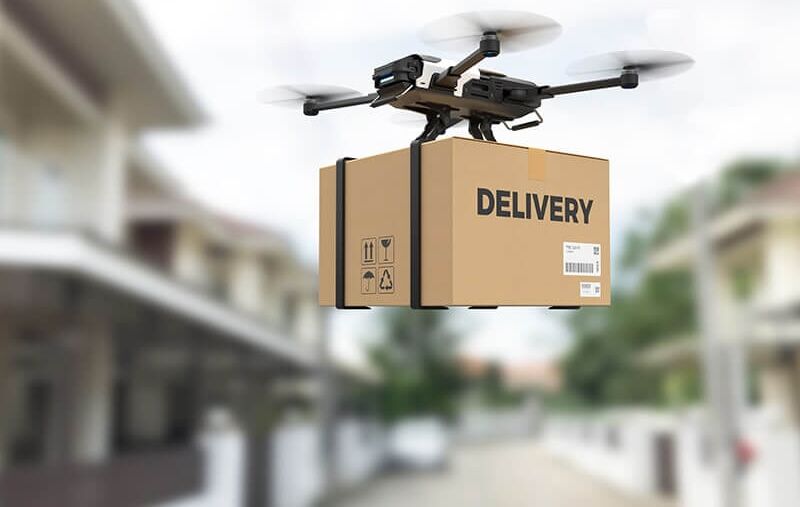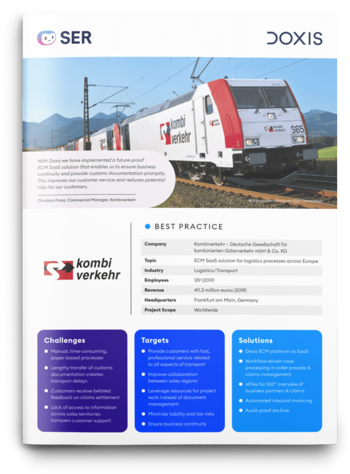SER Blog Innovation & Technology
Logistics 4.0: Everything you need to know
Drones flying through the air with packages, driverless vans loading themselves and making deliveries – these are the images that many people have in mind when they think about the logistics of tomorrow. However, much more is going on behind the scenes of the digital transformation. To understand these developments, let’s take a closer look at Logistics 4.0. What do you mean by that? What are the objectives of the fourth revolution in logistics and what technologies are driving it? The following provides an overview of Logistics 4.0.

What is Logistics 4.0?
The term Logistics 4.0 is derived from the fourth industrial revolution. On the one hand, it is a response to the impact of Industry 4.0. On the other hand, it also is actively helping to shape it.
The focus of Logistics 4.0 is automation and digitalization in transport, as well as in storage, procurement and distribution of goods, people, and information. It's about networking and coordinating internal and external logistics processes and value chains, using innovative solutions, concepts, and technologies.
Developments in Industry 4.0
Industry 4.0 refers to the fourth industrial revolution. After mechanization, mass production, and computer-aided automation, this has been characterized by digital transformation and internet connectivity for more than ten years.
Add to this technologies such as artificial intelligence (AI) and virtual reality, which, in addition to machine-to-machine communication, are increasingly bringing collaboration between machines and humans to the fore – a trend that is often referred to as Industry 5.0.
Industry 4.0 and Logistics 4.0 go hand-in-hand
The concepts of Industry 4.0 and Logistics 4.0 are not separate revolutions, but work closely together. Without adapted, modern logistics, a transformation of the industry makes little sense or is even impossible. The change in logistics paves the way for advancing digitalization in other areas of the company.
This can be seen, for example, in internationalization: International trade requires logistics that are able to transport products and goods across national borders without a hitch, for example, using digital consignment notes and mobile communication technologies. Concepts such as just-in-time procurement and the entire supply chain management also only work with logistics expertise. The fact that modern logistics and production are closely linked is a basic requirement for mastering the current challenges in the industry.

kombiverkehr: ECM SaaS solution for logistics processes across Europe
Find out how Kombiverkehr uses Doxsi4 SaaS to ensure business continuity, contactless logistics processes and smooth collaboration with authorities and service teams.
Read nowObjectives and benefits of Logistics 4.0
Logistics 4.0 particularly pursues the four goals of networking, decentralization, real-time capability, and service focus:
Networking: A high level of networking ensures more transparency in the supply chain and optimizes collaboration. Building international networks also creates the opportunity to improve negotiating scope and access to resources, as well as opening new markets.
Decentralization: The decentralized control of logistics processes increases flexibility. Instead of a rigid value chain, an intelligent network is developing that adapts flexibly and resiliently to changes.
Real-time capability: Networking makes it possible to control, monitor, and continually improve processes in real time. It is important to ensure high data quality and to evaluate the information in a structured manner.
Service focus: Logistics 4.0 keeps in mind the needs of customers. The big goal is to deliver the right product in the right quality and quantity at the right time to the right place and at the right cost (6R of logistics). Personalized services and products have to likewise win over customers and develop their loyalty to the business.
In other words, it's about increasing the efficiency and effectiveness of logistics with the help of an end-to-end, digital supply chain management.
Logistics 4.0 technologies – examples
The technologies of interest for state-of-the-art logistics include networked processes and objects that control and organize themselves. There is also a need for suitable platforms for logistics data that manage, analyze, and make usable large quantities of information.
Internet of Things
The term “Internet of Things” (IoT) encompasses various technologies that connect physical and virtual objects. These include, for example:
- RFID (radio frequency identification): RFID makes it possible to exchange information via radio waves. This is faster than using barcodes. In logistics, RFID is used, among other things, to identify, locate and track goods during warehouse operations. The RFID sensors are attached to the pallets and record important information such as expiry date, origin and destination of the goods.
- Sensors: Additional data can be collected automatically using sensors. Volume measurement systems measure packages on the conveyor system and enable optimal utilization of the loading space and precise calculation of transport capacities. Other sensors monitor temperature, humidity and light intensity in the warehouse or the condition of the goods during transport.
- Machine-to-machine communication: This refers to automated communication between devices. Information such as the current location of goods and vehicles is exchanged in real time between the end devices (machines, vehicles, containers, etc.). This supports just-in-time production and allows a quick response to incidents such as delivery delays or damage.
- Artificial intelligence: AI goes one step further. It ensures that the devices learn and make decisions themselves. For example, it independently determines the best route for transporting goods, or plans orders based on historical values and forecasts. AI also supports predictive maintenance and proactively initiates maintenance to continuously ensure a high quality standard and avoid failures.
- Cloud Computing: Cloud computing brings IoT solutions from devices to the cloud. Information can be viewed and processed at any time and from anywhere using cloud-based software.
Use Case: The inventAIRy® X drone supports automated inventory recording in pallet rack warehouses. Using sensors and cameras, the autonomous flying robot records not only inventory levels but also temperature, packaging condition, possible damage and more. It can also locate lost goods.
Cyber-physical systems (CPS)
Closely related to the IoT concept are cyber-physical systems (CPS). The focus here is on building and controlling complex infrastructures and systems by networking software, modern information technology, and mechanical components. The components are coordinated with each other so that they act autonomously. IoT sensors are, so to speak, the eyes of the CPS.
In logistics, CPS are used, among other things, to monitor the flow of goods in intralogistics, manage inventory, automatically maintain machines, and control autonomous vehicles.
Use Case: With the help of technologies such as the inventAIRy® X drone, autonomous flying robot systems can be developed that take inventory independently. Driverless transport systems (AGVs) are also among the CPS that are shaping transport logistics 4.0. These are floor-mounted conveyor systems for the intralogistics transport of goods. One example of this is the “MultiShuttle Move,” which moves freely around the storage area using state-of-the-art navigation technology, and helps with storage and retrieval of standard containers. Another AGV solution is the “Rack Racer,” a climbing shuttle that moves vertically and horizontally on the shelf.
Digital twins
The digital twin is a virtual replica of a real object. In logistics, the digital twin is a copy of the real supply chain based on real-time data. It accurately reflects the conditions and behavior of physical objects and processes. The best way to control the real supply chain is through visualizations, analyses, predictions, and simulations.
Use Case: In 2019, the Port of Rotterdam sent “Container 42” on a global data collection trip for two years to use the information for a digital twin of the port. The container, equipped with modern measurement technology and sensors, provided real-time data on transport conditions, such as infrastructure, water, and air. The port also uses the findings to develop systems with autonomous ships.

Streamlining information management in global logistics
This must-have guide shows logistics providers how they can streamline their information management to improve global collaboration and the benefits of modernizing their enterprise content management. Download your free copy.
Read nowEnterprise content management (ECM) system
In order to process the huge flood of information, standardized information management is needed. An enterprise content management (ECM) system helps companies to efficiently manage, structure, and evaluate their documents and data – and thus avoid dark data. It also supports the automation of business processes, and simplifies collaboration between departments and locations.
In logistics, ECM is used to minimize paper-based processes and instead implement end-to-end digital supply chain management. The great importance of data in Logistics 4.0 also makes data protection a central task. You can ensure the security of your company data using a modern ECM.
Use Case: With the help of the GDPR-compliant ECM system Doxis, you ensure a fast and transparent flow of information and can, for example, inform your customers at any time about the status of deliveries. The AI-supported platform automatically extracts relevant information from shipping documents, archives your shipping documents centrally and in a legally secure manner, and initiates individual workflows to accelerate logistics business processes.
Logistics 5.0 – what will change?
While Logistics 4.0 focuses on networking and communication between machines, Logistics 5.0 puts the spotlight back on people. Technologies like AI are not intended to replace human work. It is also not possible to rely entirely on machines. Instead, it's about developing methods by which humans and machines can work together ideally.
The goal is a symbiotic collaboration that leverages the strengths of both parties. The machine automates recurring processes, calculates and analyzes large amounts of data, while humans interpret the results and develop creative solutions.
Aspects such as sustainability and resilience also play an important role. For example, technologies such as autonomous vehicles, efficient route planning, real-time data analysis or the use of blockchain enable more sustainable and resilient logistics that respond to the needs of society and the environment.
FAQ – Logistic 4.0
The latest digitization trends, laws and guidelines, and helpful tips straight to your inbox: Subscribe to our newsletter.
How can we help you?
+49 (0) 30 498582-0Your message has reached us!
We appreciate your interest and will get back to you shortly.




